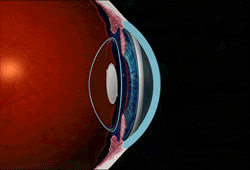Presbyopia is a vision condition in which the lens loses its flexibility, making it difficult to focus on close
 |
Presbyopia makes it difficult to focus on close objects.
|
objects. During the early and middle years of life, the crystalline lens of the eye has the ability to focus both near and distant images by getting thicker for near objects and thinner for distant objects. When this ability is lost, presbyopia results.
Symptoms of presbyopia:
- Blurry close vision that starts after age 40
- Difficulty adjusting focus when switching from near to distance vision
- Eye fatigue along with headaches when doing close work
 |
As we age, the lenses in the eye lose some of their elasticity. Click on the picture for animation.
|